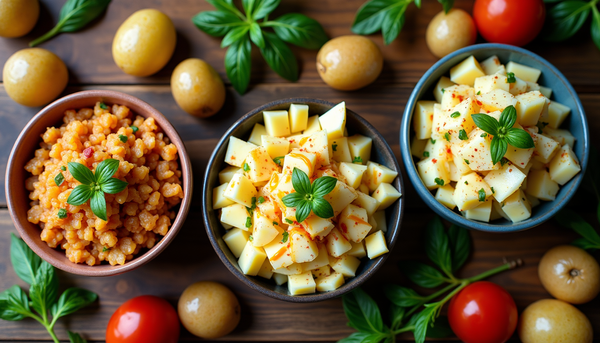Why I'm Not Sorry for "Ruining" Traditional Pozole

Why I'm Not Sorry for "Ruining" Traditional Pozole
Look, I'm about to commit what some might call culinary sacrilege. I'm going to tell you how to make pozole in 30 minutes using canned beans and store-bought salsa verde, and honestly? I'm not even a little bit sorry about it.
This whole thing started last winter when my neighbor Mrs. Rodriguez found me crying over a pot of what was supposed to be "authentic" pozole rojo. Three hours in, after burning my first batch of rehydrated chiles and somehow managing to make my pork taste like cardboard, I was ready to order takeout and call it a day.
"Mija," she said, peering into my kitchen with that look that says bless your heart in any language, "who told you cooking had to be suffering?"
The Permission Slip You Didn't Know You Needed
Here's the thing about traditional recipes—they're incredible, time-tested, and often the result of generations perfecting techniques. But they're also products of their time, when someone (usually a woman) had all day to tend to a simmering pot.
I love my abuela's stories about spending entire Sundays making pozole from scratch, but I also live in 2024, where my Sunday might include grocery shopping, meal prep, three loads of laundry, and trying to maintain some semblance of work-life balance.
Mrs. Rodriguez taught me something that day: there's a difference between respecting a tradition and being imprisoned by it. She showed me her own weeknight pozole hack—something she'd never write down or share publicly but had been making for her family for years.
"The soul of the dish isn't in suffering," she laughed, opening a can of pinto beans. "It's in gathering around the table."
Why Shortcuts Aren't Cheating (They're Evolution)
Before anyone comes for me in the comments, let me drop some food science on you. The Maillard reaction that creates those deep, complex flavors we love? It happens whether your spices come from whole dried chiles you toasted yourself or from a really good chili powder blend. Your taste buds don't have a purity detector.
And those canned beans everyone's so snooty about? They're literally pressure-cooked to perfection. That's not lazy—that's efficient.
I started thinking about this differently after reading about how "traditional" Italian tomato sauce would've been impossible before tomatoes arrived from the Americas. Food evolves. Techniques adapt. Fusion happens whether we like it or not.
My vegetarian pozole isn't traditional, and I'm not pretending it is. But it is a damn good bowl of soul-warming soup that you can actually make on a Tuesday night when you've got 30 minutes and a grocery store's worth of pantry staples.
The Recipe That Changed My Mind About Shortcuts
What You'll Need:
- 1 tablespoon olive oil
- 1 small yellow onion, diced
- 1 large poblano pepper, cored and diced (or bell pepper if you're spice-sensitive)
- 4 cloves garlic, minced
- 2 teaspoons each: ancho chili powder, regular chili powder, ground cumin
- 4 cups vegetable broth
- 2 (15-ounce) cans beans—I mix pinto and white, but live your truth
- 1 (30-ounce) can hominy, rinsed and drained
- ¾ cup salsa verde (the good stuff, not the watery kind)
- 1 teaspoon dried oregano
- 2 tablespoons fresh lime juice
- Salt and pepper to taste
For the toppings (don't skip these, seriously):
- Chopped cilantro
- Crumbled tortilla chips
- Shredded cabbage
- Sliced avocado
- Sliced radishes
- Sour cream or Mexican crema
The Method:
Step 1: Build Your Flavor Base Heat that olive oil in your biggest pot over medium-high heat. Toss in the onion and poblano and let them get friendly for about 5 minutes. Your kitchen should start smelling amazing right about now.
Add the garlic and all those spices—ancho chili powder, regular chili powder, and cumin. Here's where the magic happens: let this cook for 2 minutes, stirring constantly. You're basically making your own chili paste without all the drama of whole dried chiles.
Pro tip: If your spices start smelling bitter instead of fragrant, you've gone too far. Start over. Ask me how I know.
Step 2: The Simmer Pour in your vegetable broth, beans, hominy, salsa verde, and oregano. This is where you realize that salsa verde is basically a flavor shortcut sent from heaven. It's got tomatillos, jalapeños, garlic, cilantro—all the things you'd add individually anyway.
Bring everything to a simmer, then lower the heat and cover. Let it bubble away for 10 minutes while you prep your toppings and wonder why you ever thought cooking had to be complicated.
Step 3: The Finish Line Stir in that lime juice, taste, and adjust. Need more salt? Add it. Want more heat? Splash in some hot sauce. Want it less spicy? Dollop in some sour cream.
This is your soup now. Make it yours.
The Toppings Are Non-Negotiable
Listen, you can take shortcuts with the base, but the toppings are where pozole really shines. That mix of textures—creamy avocado, crunchy cabbage, sharp radish, bright cilantro—that's what makes each spoonful interesting.
I like to set up a little topping station and let everyone build their own bowl. My partner always goes heavy on the avocado and light on the radishes. I'm team "pile everything on there and see what happens."
Make It Your Own
Once you've mastered this base, the world is your oyster. Or your pozole, I guess.
Want it heartier? Throw in some diced sweet potatoes when you add the broth. They'll break down slightly and make everything even more satisfying.
Missing meat? Soy chorizo, crumbled tempeh, or even leftover rotisserie chicken work brilliantly here.
Feeling fancy? Roast your poblanos and garlic before adding them. It adds about 10 minutes to your cook time but gives everything a deeper, smokier flavor.
Want to meal prep? This soup actually gets better overnight. The flavors marry and become more complex. Just add your toppings fresh when you reheat.
The Real Talk About Authenticity
Here's what I've learned from Mrs. Rodriguez and countless other home cooks who've shared their shortcuts with me: authenticity isn't about following a recipe exactly as it was written 100 years ago. It's about understanding why a dish exists and what it's meant to do.
Pozole exists to bring people together over a bowl of warming, nourishing food. It's meant to be satisfying and comforting, especially during colder months. If my 30-minute version accomplishes that—and it does—then I'd argue it's pretty authentic to the spirit of the dish.
Plus, let's be real: traditional pozole varies from region to region, family to family. There's no single "authentic" version anyway. So why not add our own chapter to the story?
Your Turn to Experiment
I want you to try this recipe, but more than that, I want you to make it yours. Swap the beans for whatever you have. Use red salsa instead of green if that's what's in your fridge. Add those vegetables that are looking a little sad in your crisper drawer.
Then tell me about it. What worked? What didn't? What made your version uniquely yours?
Because at the end of the day, the best pozole isn't the most traditional one or even the most delicious one. It's the one that gets made, shared, and enjoyed by real people living real lives.
And if that makes me a culinary rebel, well... I can live with that.
What's your favorite cooking shortcut that you're secretly proud of? Drop it in the comments—let's normalize making good food without the guilt trip.




